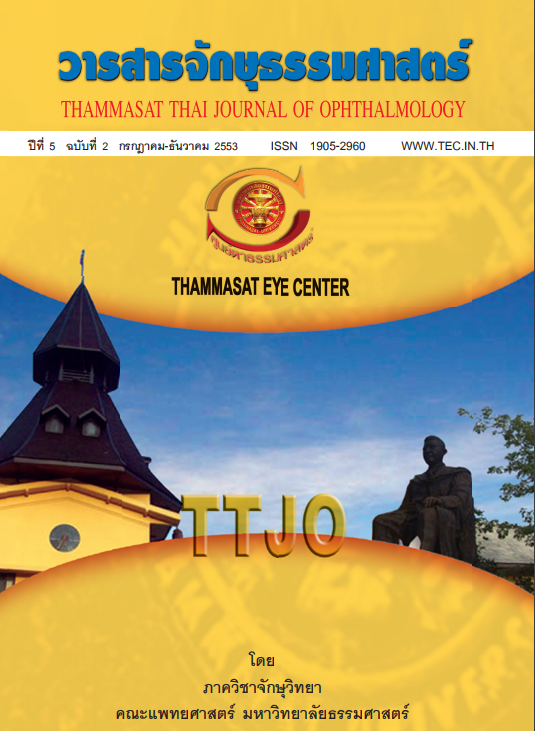ความชุกของภาวะสาตาผิดปกติในกลุ่มประชากรที่เข้ารับบริการในโรงพยาบาลธรรมศาสตร์เฉลิมพระเกียรติ
Main Article Content
Abstract
ตถุประสงค์: เพื่อศึกษาหาความชุกของผู้ที่มีภาวะสายตาผิดปกติในกลุ่มประชากรที่มารับบริการในโรงพยาบาลธรรมศาสตร์เฉลิมพระเกียรติ
รูปแบบการศึกษา: เป็นการศึกษาแบบ case series
วิธีการศึกษา: ทำการเก็บข้อมูลวิจัยเชิงพรรณา โดยการเก็บข้อมูลจากประชากรที่มารับบริการในโรงพยาบาลธรรมศาสตร์เฉลิมพระ เกียรติ และสนใจตรวจสายตา โดยทำการตรวจสายตาโดยเครื่อง Automated refraction ในช่วงระหว่างวันที่ 13 ธันวาคม 2553 ถึง 17 ธันวาคม 2553 จำนวน 544 ราย
ผลการศึกษา: ผู้สนใจรับการตรวจสายตาจำนวน 544 รายเป็นเพศชาย 249 คน (45.77%) เพศหญิง 295 คน (54.23%) ค่ามัธยฐานของอายุของผู้ที่เข้ารับการตรวจ คือ 47.47 ปี มีผู้ที่มีปัญหาสายตาสั้น 242 คน (44.49%), ผู้ที่มีปัญหาสายตายาว 218 คน (40.04%) และผู้ที่มีปัญหาสายตาเอียง 75 คน (13.79%), ผู้แก้ปัญหาโดยการสวมแว่นตา 50.47% ส่วนใหญ่ตัดแว่นตาจากร้านแว่นตา 75.73%
สรุป: ภาวะสายตาผิดปกติเป็นปัญหาที่พบได้บ่อย แต่คนส่วนใหญ่อาจไม่ได้ให้ความสำคัญ หรืออาจไม่พบว่าเป็นปัญหาหากภาวะที่เป็นไม่ได้กระทบต่อชีวิตประจำวัน ดังนั้นปัญหาส่วนใหญ่จึงไม่ได้รับการแก้ไข และคนส่วนใหญ่ที่ใช้แว่นตาก็นิยมตัดแว่นตาจากร้านแว่นตามากกว่าการมาพบจักษุ แพทย์
Prevalence of Refractive Error in Subjects Presenting to
HThammasat hospital
Objective: To study the prevalence of refractive error in subjects presenting to Thammasat hospital.
Study design: case series
Material and Method: To collect data from subjects who received health service in Thammasat hospital. The refractive status was measured by auto refractometer in health promotion week between 13th December 2010 - 17th December 2010.
Results: There were 544 people who attended to measure the refractive status (249 male and 295 female). The median value of the age of subjects was 47.47 years old. There were 242 persons with myopia (44.79%), 218 persons with hyperopia (40.07%) and 75 persons with astigmatism (13.79%). All of the individuals who have refractive error, there were 50.74% of these persons who already have eyeglasses to correct problem (75.73% from spectacles shop)
Conclusion: Refractive error is a common problem in general populations, but most of them may not concern to this problem or it does not affect their daily livings, therefore the problem might not be resolved. We found that the persons who have refractive error and corrected by eyeglasses would prefer to buy spectacles from optical shop rather than ophthalmology clinic.
Article Details
References
Prevalence of myopia and hyperopia in 6- to 72-month-old african american and Hispanic children: the multi-ethnic pediatric eye disease study. Ophthalmology Jan;117(1):140-7 e3.
Kasten E, Vorwerk C. The prevalence rates of refractive errors among children, adolescents, and adults in Germany. Clin Ophthalmol2008 Sep;2(3):601-7.
Yekta A, Fotouhi A, Hashemi H, Dehghani C, Ostadimoghaddam H, Heravian J, et al. Prevalence of refractive errors among schoolchildren in Shiraz, Experiment Ophthalmol Apr;38(3):242-
He M, Huang W, Li Y, Zheng Y, Yin Q, Foster PJ. Refractive error and biometry in older Chinese adults: the Liwan eye study. Invest Ophthalmol Vis Sci2009 Nov;50(11):5130-6.
Nangia V, Jonas JB, Sinha A, Matin A, Kulkarni M. Refractive error in central India: the Central India Eye and Medical Study. Ophthalmology Apr;117(4):693-9.


